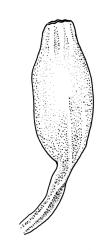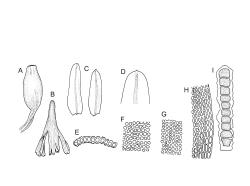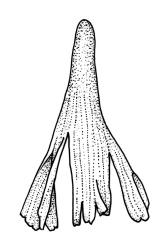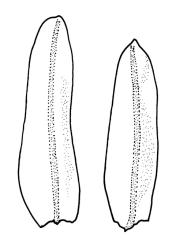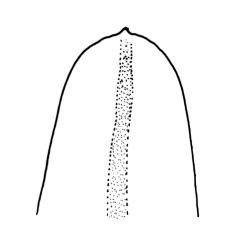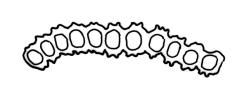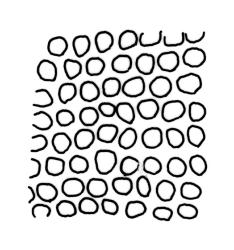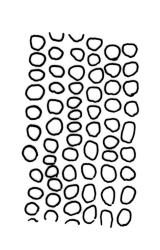- ≡ Micromitrium brevicaule Besch., Ann. Sci. Nat., Bot. sér. 5, 18: 211 (1873)
- = Macromitrium wattsii Broth., Öfvers. Finska Vetensk.-Soc. Förh. 40: 169 (1898)
- = Macromitrium subfragile Dixon & Sainsbury in Sainsbury, Trans. & Proc. Roy. Soc. New Zealand 75: 178 (1945)
Plants small and compact, dull, yellow-green to bright green above, olive-green or brown below. Branches short, <1.0–3.0(–7) mm, ascendant, simple or forked below sex organs. Stem leaves erect-twisted when dry, spreading when moist, 0.8–1.2 mm, broadly lanceolate to ovate-lanceolate, bluntly acute or narrowly obtuse. Branch leaves tightly and stiffly spiralled around branch and with apices ± subcucullate to incurved when dry, erect-spreading, straight, and not funiculate when moist, oblong-ligulate to broadly oblong, obtuse, often mucronate, moderately keeled, with a single plication below, 1.0–1.8 mm; margins entire or slightly crenulate above, plane; upper laminal cells mostly rounded-subquadrate, firm-walled, obscured by dense, low, simple or forked papillae, bulging, unistratose, 6–9(–12) µm wide, with 1–2 rows at margins sometimes less obscure; mid laminal cells similar in shape and size, less strongly papillose and less obscure, becoming progressively more oblong and smoother towards base; inner basal cells oblong-rectangular or elliptic, thick-walled, clear, flat, and smooth, mostly 9–18 × 3–6 µm; marginal basal cells thinner-walled, ± hyaline, forming a short, indistinct border. Costa percurrent or short-excurrent as a mucro, stout (c. 40–45 µm wide in lower leaf and scarcely tapered), shiny and protruding on abaxial surface when dry, the abaxial superficial cells elongate and smooth throughout, in cross-section consisting almost entirely of stereids (including 3–5 rows of abaxial stereids), and with 3–4 poorly developed adaxial guide cells. Gemmae often present on adaxial laminal surface or in axils of leaves, linear, uniseriate, papillose, brown, composed of c. 13–22 quadrate cells and c. 270–360 µm long.
Pseudautoicous. Perichaetial leaves similar to vegetative. Dwarf male plants axillary. Setae 3–5 mm, smooth, straight or flexuose, moderately thick, weakly sinistrorse; capsules ovate-elliptic and weakly sulcate throughout when moist, narrowly ovate to ovate-cylindric with 8 weak grooves and narrowed at mouth when dry, 1.3–1.7(–2.0) mm; exothecial cells firm-walled (with bands of firmer-walled cells corresponding to ridges), mostly oblong or rounded-rectangular and 30–60 µm long, becoming shorter and thicker-walled at mouth; stomata, annulus, and operculum as per genus. Peristome single; exostome teeth 16, erect or inflexed dry or moist, irregular, blunt, pale, finely papillose to papillose-striate, c. 60–160 µm; endostome absent. Calyptra fimbriate and often pale at base, smooth, plicate, naked, c. 1.5–2.5 mm. Spores variable in diameter and indistinctly anisosporous, thick-walled, 12–24 µm, finely papillose to nearly smooth.
Vitt 1983, figs 145, 149–150, 179–188; Beever et al. 1992, fig. 36h.
Macromitrium longirostre s.l., often in coastal situations, also has dry leaves spirally twisted around the branches and sometimes has short basal cells. It is differentiated from M. brevicaule by having smooth and often partially bistratose upper laminal cells and leaf apices usually reflexed when dry. The two species appear to overlap in distribution only on Chatham Is.
K; NI: N Auckland, including offshore islands (TK, PK, HC, LB, GB, RT), S Auckland (Coromandel Peninsula, near Tauranga); Ch.
Australasian. Recorded from eastern mainland Australia, Lord Howe Island, Norfolk Island, and New Caledonia by Vitt & Ramsay (1985, p. 382).
Occurring on both rock and tree trunks in the salt spray zone and often very conspicuous in suitable northern habitats. It occurs on a variety of rock types including rhyolite, basalt, breccia, and ultramafics. Epiphytic populations occur mostly on Metrosideros excelsa but the species is also documented from Corynocarpus laevigatus (on Kermadec Is) and Cordyline kaspar (on Poor Knights Is). Ranging from sea level to c. 120 m elevation (at Surville Cliffs, N Auckland L.D.) on the North I.
Macromitrium brevicaule is fairly frequent along the North I. coast north of Tauranga Harbour on the east coast and Manukau Harbour on the west coast. Peter de Lange (in herb.) considers it to be "easily the most common Macromitrium" on Raoul Island (in the Kermadecs). There is no reason to question Vitt’s (1983) suggestion that it is a relatively recent arrival to N.Z. by long-distance dispersal from eastern Australia; nor is there any reason to consider it adventive here.
Occasional collections (E.K. Cameron 2457a from Three Kings Is, CHR 104729; L.B. Moore s.n. from Poor Knights Is, CHR 398315) have leaves that are strongly eroded, in extreme cases nearly reduced to only costae. Vitt (1983) described the spores here as "indistinctly anisosporous, variable"; I have seen spores only between 12–24 µm but I concur that they are variable in size and appear to be anisosporous. Although male plants and the pseudautoicous sexuality of this species are described by Vitt, I have been unable to find male plants. Lactic acid is useful to clear the very opaque upper laminal cells prior to microscope examination.
The combination of broad leaves with distinctly multipapillose upper cells and short basal cells distinguishes this species from all other N.Z. congeners. Recognition is also facilitated by its compact habit, and oblong-ligulate and obtuse leaves stiffly spiralled around the short branches, as well as its presence in northern and coastal habitats. It frequently fruits and its relatively short, left-twisting setae and naked and plicate calyptrae provide further distinction.
This Australasian species is the only species in N.Z. placed by Vitt & Ramsay (1985) with three other predominantly Australian species in their "M. aurescens group".



